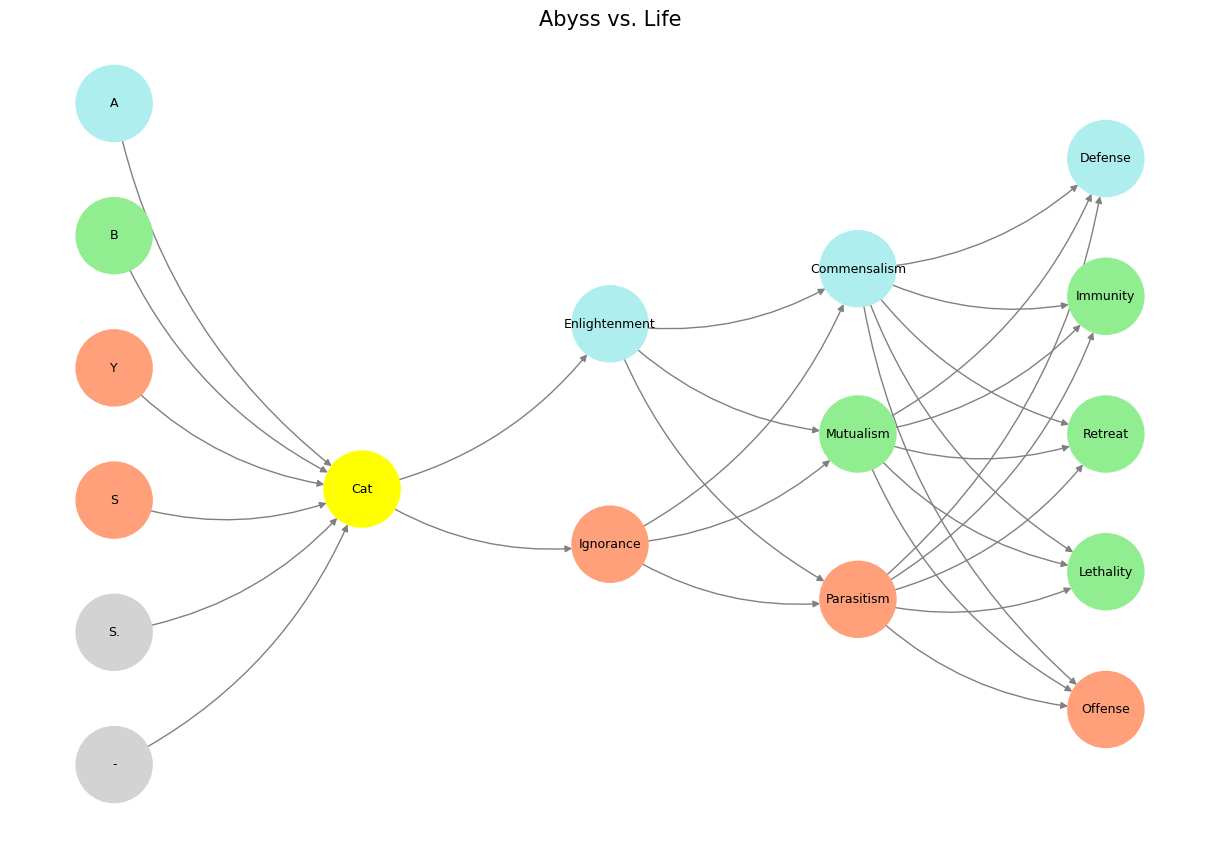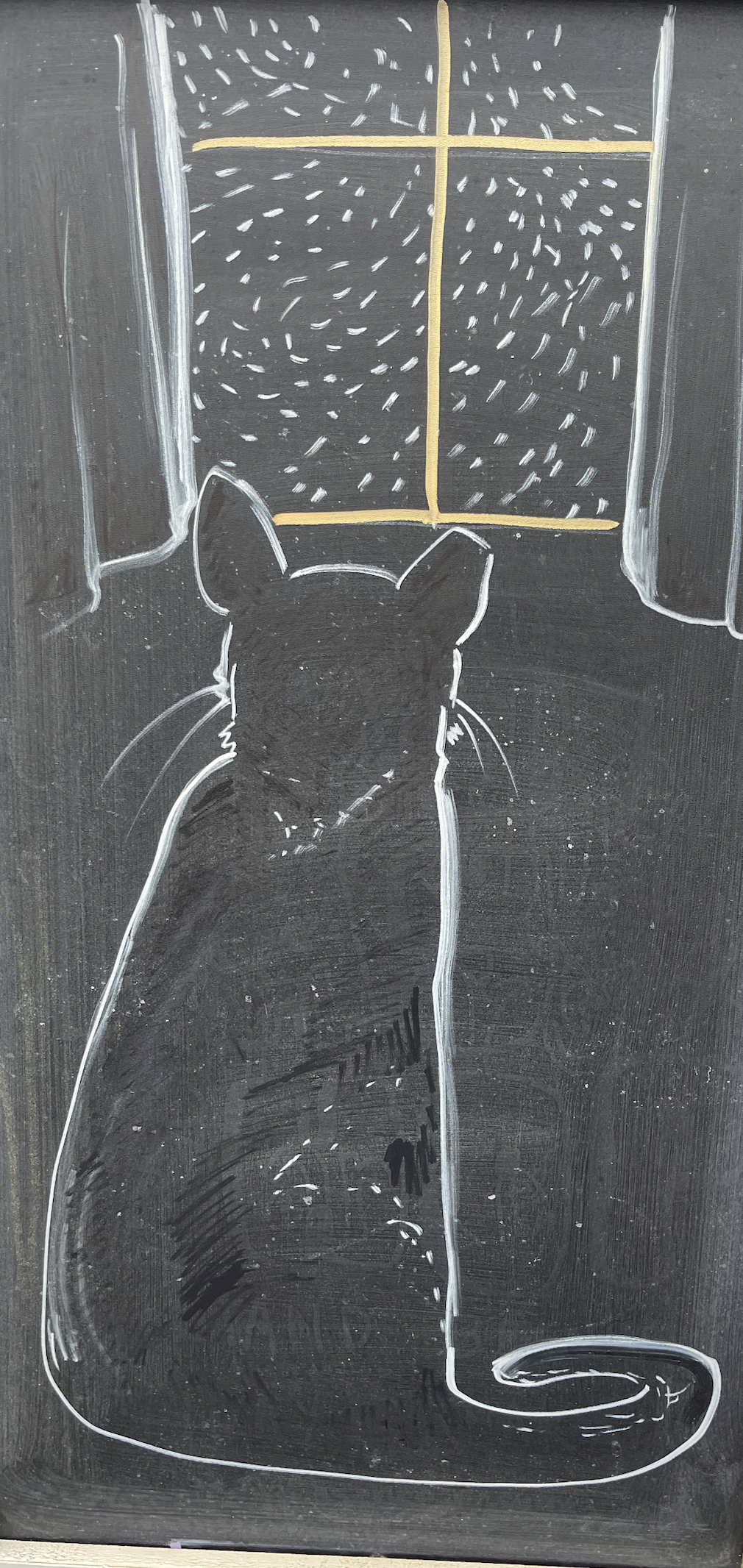Tactical#
A cat sits, staring through the window at the starry night – as Vincent once did, also through a window. The simple composition—a dark silhouette of the cat against the bright, geometric lines of the window frame and the chaotic flurry of the cosmos—is profoundly symbolic. The image invites us to interpret not just the scene but the cat’s possible interiority: what does the cat see, and, more importantly, what does it feel? This isn’t Leopald Bloom’s feline walking stiffly round a leg of the table with tail on high, oppressed by a more visceral hunger and sounding this interiority to Bloom:
But he did too acknowledge something. That they call them stupid. Yet they understand what we say better than we understand them. She understands all she wants to. Vindictive too. Cruel. Her nature. Curious mice never squeal. Seem to like it. Wonder what I look like to her. Height of a tower? No, she can jump me. Afraid of the chickens she is, Bloom said mockingly. Afraid of the chookchooks. I never saw such a stupid pussens as the pussens.
—Mrkrgnao!
The cat said loudly. She blinked up out of her avid shameclosing eyes, mewing plaintively and long, showing him her milkwhite teeth. He watched the dark eyeslits narrowing with greed till her eyes were green stones. Then he went to the dresser, took the jug Hanlon’s milkman had just filled for him, poured warmbubbled milk on a saucer and set it slowly on the floor.
—Gurrhr!
She cried, running to lap.
Existential Dread and Mutualism: Reflections Through a Window#
This moment evokes the idea of existential dread in its purest form, a concept Nietzsche so eloquently explored. The cat is not merely looking at snow; it is gazing into the beyond, a realm that is both inviting and indifferent. The falling snow might symbolize the ephemeral nature of existence—each flake unique but destined to melt into anonymity. And yet, there is also the serene beauty of the moment: the cat, seemingly content in its solitude, embodies a quiet confrontation with the void.
Fig. 1 Many Have Stared Into the Abyss. A psychedelic experience is a journey to new realms of consciousness. The scope and content of the experience is limitless, but its characteristic features are the transcendence of verbal concepts, of spacetime dimensions, and of the ego or identity.#
The framing of the window enhances this contemplation. Much like the philosopher’s search for meaning within the bounded structure of thought, the window’s rigid lines contrast with the wild unpredictability of the snow. It asks a question Nietzschean in nature: can we find meaning in a universe that offers none?
The Cat as a Metaphor for Heideggerian “Being-Toward-Death”#
The cat’s quiet posture is strikingly similar to Heidegger’s concept of “Being-Toward-Death.” Animals often exhibit behaviors that resonate with human existential concerns—not because they share our reflective capacity, but because their instinctual existence often mirrors our own confrontation with the unknown. Is the cat reactive or reflective? This ambiguity makes the scene even more compelling, blurring the line between instinct and contemplation.
A salamander in isolation, as mentioned elsewhere, might represent a more primal confrontation with the void. Yet the cat, positioned at the threshold of the window, introduces an additional layer. Its gaze is not inward but outward, yearning not just for survival but for understanding. The snowflakes fall, the abyss stares back, and the cat remains—unmoved yet not unaffected.
From Existentialism to Cosmic Yearning#
The juxtaposition of the cat and the snow recalls Van Gogh’s Starry Night. If what’s outside the window were the night sky rather than snow, the scene could transform into one of cosmic yearning. The cat’s stillness would then echo humanity’s desire to transcend its physical confines and touch the infinite. Perhaps the snow itself serves as a proxy for the vast unknowable, the swirling flurry mirroring the chaos of galaxies.
Starry Night often embodies the tension between beauty and turmoil, order and chaos. The cat staring at the snow achieves something similar. Its vigil is not merely passive; it is an active engagement with the sublime—a silent witness to a world far larger than itself. This engagement is not desperate but curious, not fearful but accepting.
Tryptophan and the Abyss#
To bring this meditation into the realm of biology, consider the molecule tryptophan—a precursor to serotonin and melatonin, the very chemicals that regulate mood and sleep. The metaphor of looking into the abyss finds a curious parallel here. Just as the cat gazes through the window, tryptophan’s biochemical pathway traverses the boundary between the mundane and the transcendent. Its journey through the kynurenine pathway, altering in response to stress or serenity, mirrors the cat’s moment of stillness. It is both grounded in the physical and symbolic of the metaphysical.
Mutualism and Commensalism: A Tactical Frame#
Tevin’s lyrics:
Just us two ‘til the end (commensalism)
I’ve learned my lesson (mutualism)
Don’t take this as an aggression (parasitism)
– Tevin
Offer a framework for understanding relationships within this tableau. The cat’s interaction with its environment could be seen as commensal: it takes from the scene a sense of calm or wonder without altering it. Yet there’s also mutualism in the human observer’s interpretation—the scene gives meaning, and the observer enriches it through reflection. This balance underscores the interdependence of perception and reality.
Conclusion: The Cat, the Window, and the Void#
This simple image—a cat staring at snow through a window—transcends its apparent simplicity. It captures the layered uncertainty of existence, echoing themes of Nietzschean and Heideggerian philosophy, while grounding itself in biological and emotional resonance. The cat is not just a passive observer but a participant in a larger, cosmic drama. Its gaze reminds us that the abyss is not merely something to fear; it is also something to embrace. For in staring at the snow, the cat—like us—finds both its smallness and its place within the infinite.
Show code cell source
import numpy as np
import matplotlib.pyplot as plt
import networkx as nx
# Define the neural network structure
def define_layers():
return {
'World': ['-', 'S.', 'S', 'Y', 'B', 'A', ],
'Perception': ['Cat'],
'Agency': ['Ignorance', 'Enlightenment'],
'Generativity': ['Parasitism', 'Mutualism', 'Commensalism'],
'Physicality': ['Offense', 'Lethality', 'Retreat', 'Immunity', 'Defense']
}
# Assign colors to nodes
def assign_colors():
color_map = {
'yellow': ['Cat'],
'paleturquoise': ['A', 'Enlightenment', 'Commensalism', 'Defense'],
'lightgreen': ['B', 'Mutualism', 'Immunity', 'Retreat', 'Lethality'],
'lightsalmon': [
'Y', 'S', 'Ignorance',
'Parasitism', 'Offense'
],
}
return {node: color for color, nodes in color_map.items() for node in nodes}
# Calculate positions for nodes
def calculate_positions(layer, x_offset):
y_positions = np.linspace(-len(layer) / 2, len(layer) / 2, len(layer))
return [(x_offset, y) for y in y_positions]
# Create and visualize the neural network graph
def visualize_nn():
layers = define_layers()
colors = assign_colors()
G = nx.DiGraph()
pos = {}
node_colors = []
# Add nodes and assign positions
for i, (layer_name, nodes) in enumerate(layers.items()):
positions = calculate_positions(nodes, x_offset=i * 2)
for node, position in zip(nodes, positions):
G.add_node(node, layer=layer_name)
pos[node] = position
node_colors.append(colors.get(node, 'lightgray')) # Default color fallback
# Add edges (automated for consecutive layers)
layer_names = list(layers.keys())
for i in range(len(layer_names) - 1):
source_layer, target_layer = layer_names[i], layer_names[i + 1]
for source in layers[source_layer]:
for target in layers[target_layer]:
G.add_edge(source, target)
# Draw the graph
plt.figure(figsize=(12, 8))
nx.draw(
G, pos, with_labels=True, node_color=node_colors, edge_color='gray',
node_size=3000, font_size=9, connectionstyle="arc3,rad=0.2"
)
plt.title("Abyss vs. Life", fontsize=15)
plt.show()
# Run the visualization
visualize_nn()


Fig. 2 Kynurenine. Now that’s a molecule that asks you to look into the abyss. Looks like Plato had his cave, the Wachowski’s had their matrix, and our Feline has the abyss. Ain’t that somethin’? Meanwhile, the teenage Kevin only has time for life’s little games – not yet as deep, contemplative as a grownup Feline!#

